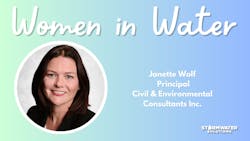When Stormwater Solutions first approached me about writing an article on erosion my immediate reaction was “Yes! Absolutely. No sweat.”
This topic has been embedded in my almost 20-year professional career, how hard can it be to write an article on erosion? As I started to think about what I could share that has not been shared before, the topic became more daunting…my confidence was eroding before my eyes (see what I did there?). As I sat down to collect my thoughts, I decided that I would share my own personal journey with erosion and how it has helped me build relationships and shape my professional future.
Erosion control kick-off
I began my career with Civil & Environmental Consultants, Inc. (CEC) 17 years ago, as a young engineer ready to make a difference. On my second day on the job, I was working out of our modest laboratory conducting small-scale flume testing via ASTM Standard D5141 that is often utilized to evaluate silt fence efficiency at sediment removal. The work was fun, and hands on; science that you could see, with a practical application. Plus, it produces lots of data, something that I enjoyed analyzing then and still do today. My eagerness to work in the field propelled me into performing erosion prevention and sediment control inspections on linear construction projects. I did not realize then, but this opportunity was going to shape the rest of my career.
The State of Tennessee uses the acronym Erosion Prevention and Sediment Control (EPSC). In many other states, and even sometimes in my home state, this is referenced as Erosion and Sediment Control (E&SC). I have no real beef with either acronym, it is the same message, but I tend to the former. It could be that it is because it is the acronym used by the state where I started my career; however, more likely, it is because it points towards the two different actions for which we are planning. Erosion can be described as the dislodgement of soil particles from the surface. When we design mechanisms for minimizing erosion, we are attempting to limit soil particles from becoming detached.
However, as designers, we recognize that to construct a roadway, a shopping mall or whatever it may be, erosion is ultimately going to occur; therefore, we need sediment controls as well. Sediment controls work to capture the soil particles that have been dislodged via erosion. Best Management Practices (BMPs) can work to combat erosion or sediment, some even have an impact on both. As designers or inspectors, we need to consider BMPs for both erosion prevention and sediment control with the understanding that the better we get at preventing erosion, the greater the efficacy of the sediment controls we design, resulting in improved water quality discharging from our construction sites.
Tackling erosion control projects
One of the most exciting erosion control-based projects I worked on was a research project conducted by the Tennessee Department of Transportation (TDOT). This project was launched in response to the turbidity Effluent Limitation Guidelines (ELG) introduced by the U.S. Environmental Protection Agency (EPA) in 2009. This proposed stormwater rule would have had a huge impact on large construction and development sites across the United States. Understanding the possible outcome of this rule, TDOT immediately jumped into action and launched a statewide study to assess the range of effluent turbidity values discharging from their active construction sites. TDOT’s goal was to understand how the erosion and sediment controls implemented within their projects, with mostly passive treatments per their standards and specifications, were performing, based on effluent turbidity as the metric. The project was launched with multiple field crews equipped with handheld turbidity meters.
We soon realized that chasing rain is ineffective and the project moved towards the installation of water quality sondes, pressure transducers and automatic samplers (located at one location). As you can imagine, the study produced a world of data that required analysis, including data validation and statistics. EPSC inspection reports, along with carefully collected field and instrumentation data, were reviewed to draw conclusions. Personally, the biggest takeaway that I recall was the effectiveness of ground stabilization (i.e., temporary and permanent cover, including vegetation) on turbidity. It compounded my understanding of why our NPDES Construction General Permit includes a time-driven stabilization requirement, due to its effectiveness at controlling erosion and in turn protecting water quality. The rule was ultimately rescinded by the EPA, but the experience I gained through working on this project for TDOT was invaluable.
Skills outside of erosion control
I would like to close this article by sharing how my career with erosion has helped me develop soft skills that are difficult to teach in a classroom. As an EPSC inspector, I often found myself in the field with property owners, engineers, scientists and contractors. Each party approaches the situation with a different objective. It is both educational and rewarding to problem solve as a team. Sometimes asking questions is more productive than providing answers. I am also fortunate enough to be one of the instructors for Tennessee Statewide EPSC Inspector training program facilitated by the University of Tennessee and the Tennessee Department of Environment and Conservation.
While I am an instructor, I often find that I am also learning throughout this course. Attendees share their specific experiences and offline conversations occur where we are troubleshooting different erosion control challenges and collaborating towards a solution. Working in the erosion control field has provided me with the opportunity to work on a variety of projects ranging from design, inspection, research & development, program development, and training – I cannot wait to see what I will learn over the next 20 years.






